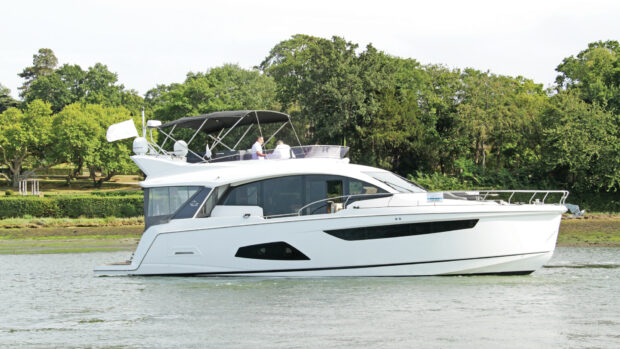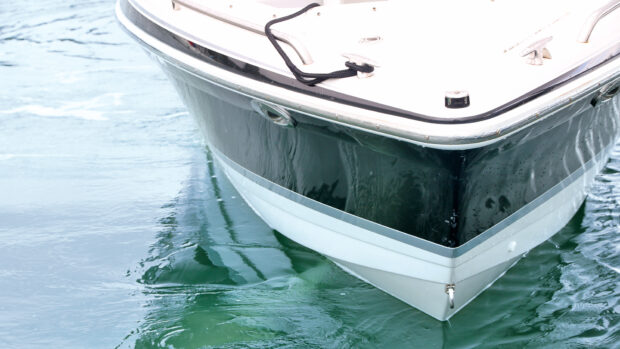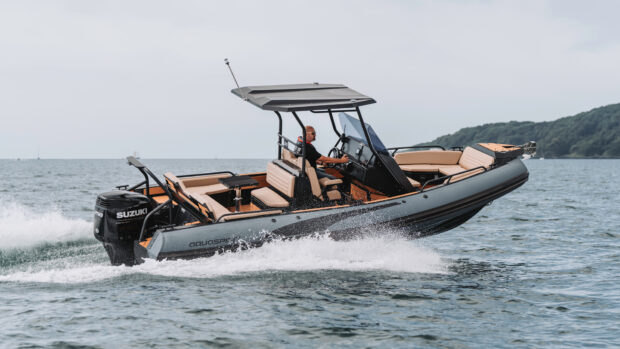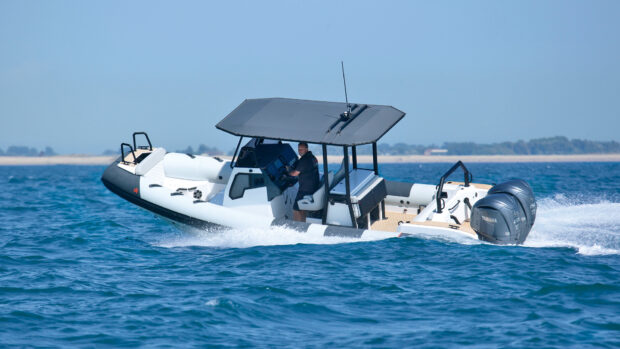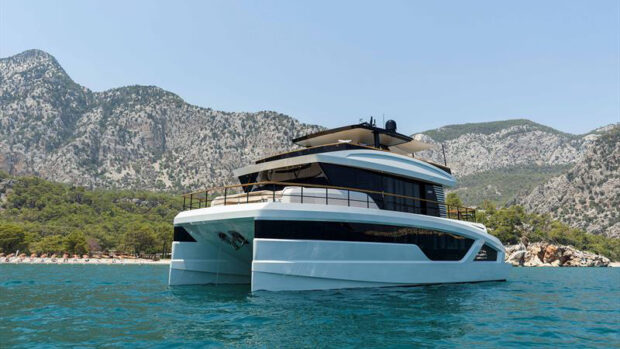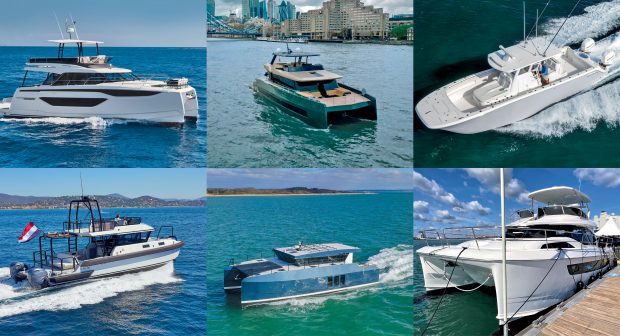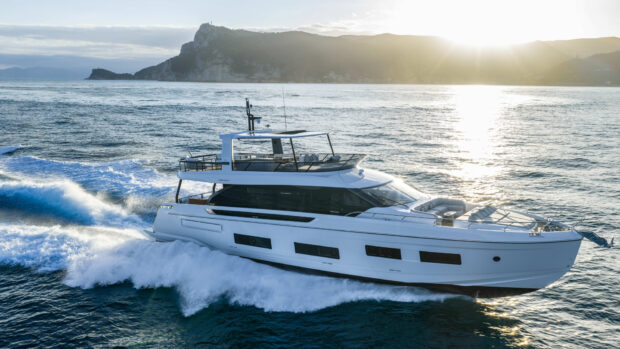The Prestige M7 powercat is a very real and convincing alternative to the traditional 70-75ft motoryacht, thanks to its high volume and cruising capabilities
The principle behind Prestige’s M Line is simple. Build a boat that delivers the deck space and volume of something much larger, alongside the running efficiency of something much smaller.
A wide-beamed powercat is of course the perfect solution to that kind of brief and Prestige has done its best to make the customer benefits behind their approach very explicit. The flagship M8, for instance, is a 65-footer that claims to offer the space of an 85-footer; the entry-level M48 (soon to be renamed the M6) is a 48-footer that brings 60ft volume to the table; and in spite of its 58ft LOA, this new model is named the M7 to reflect what Prestige deems to be its natural place among 75ft monohulls.
The starting point is a beam of nearly 25ft – around 43% of its overall length and about 9ft more than you would tend to expect of a comparable monohull. As you might anticipate, that feels pretty good on the external decks. The slightly sunken aft cockpit stretches across the full beam, with steps down to aft platforms on both sides and a big hydraulic central platform that can be raised to deck level to extend the cockpit out over the water.
You can spec this space with a large central C-shaped dinette that faces aft through a central gate toward that deck extension or you can trade that for the test boat’s asymmetrical arrangement instead. That uses a corner lounger on the port side, a large L-shaped seating unit to starboard and a single central set of steps (rather than a pair of lateral ones) to ascend to the raised saloon level. Either way, ease of movement here is outstanding, thanks to a transverse run of open deck behind the superstructure – and that’s a feature that’s broadly mirrored up at the bow.
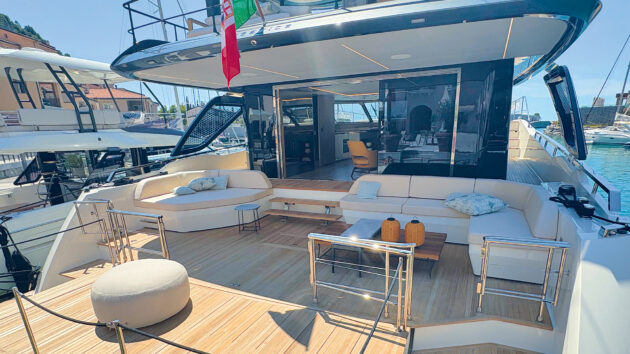
The big sunken cockpit is bookended by a hydraulic deck extension aft and a lateral walkway forward
Accessed by means of symmetrical side decks, each with some handy protection from the flared flybridge, the foredeck provides a lateral walkway ahead of the screen, so you can cross from side to side regardless of how many people there are on the sun loungers. The loungers themselves are also usefully split, providing good access forward, before they morph into a sunken forepeak bluewater multihull bow lounge for four people.
It’s great to see that feature here because it’s not generally possible on smaller Catamarans with full-beam bow cabins. And while there’s no quick route into the saloon from the bow via the screen or the starboard side deck, there is a doorway to port, alongside a well-placed side gate and a secure internal staircase to the flybridge.
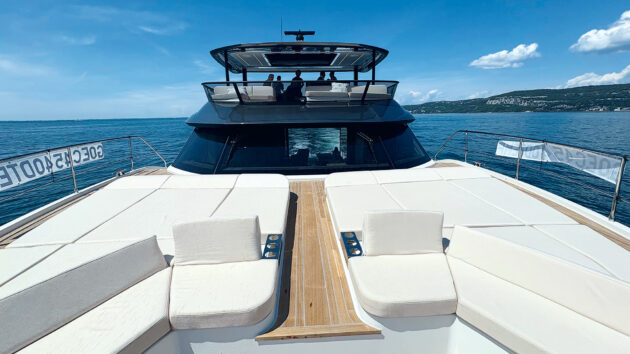
Split sunbeds morph into a lovely sunken bow lounge
When you use that staircase to head up top, you find a big L-shaped wet bar at the back end with fridge, ice maker, sink and Kenyon grill, plus a slightly raised bar with space for a couple of stools. There’s additional space for freestanding furniture to port, as well as an eight-man dining table with a pair of benches and a set of directors’ chairs further forward. And a pair of fixed sun loungers ahead of the twin helm helps make up for the absence of companion seating possibilities at the dining station.
As is so often the case, the compass could do with relocating so it lines up with the skipper and the underutilised zone to port of the console could also benefit from a little extra design imagination. But the widespread use of raw teak feels very classy, and while the test boat’s hard top is equipped with a large canvas sunroof, there’s also a really attractive option to cordon this section off as an enclosed sky lounge for extra comfort and refinement, leaving just the aft deck exposed to the outside world.
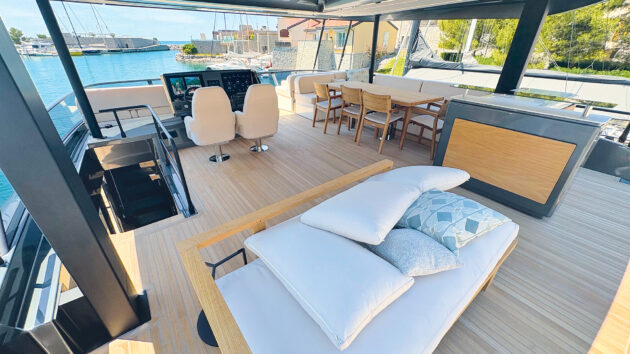
The securely contained stairwell takes you to a big flybridge with lots of furniture
Superior finish
The M7 is built at the same Monfalcone factory as the M8, where Monte Carlo Yachts used to be built. That means a slightly higher level of finish than established Prestige customers might be used to, as well as a healthy extra dose of customisation potential. In the internal saloon, that means far more openness and fewer fixed features than you might expect.
The freestanding starboard lounge is a case in point. As a rangy low-slung scattering of seats, pouffes and tables, it’s actually too low to see the horizon forward; and the fridge, cabinets and staircase obscure the views to port too. But the idea is that you can take advantage of all this deck space to spec your choice of furniture, so there’s no need to feel limited by the test boat fit-out.
Article continues below…
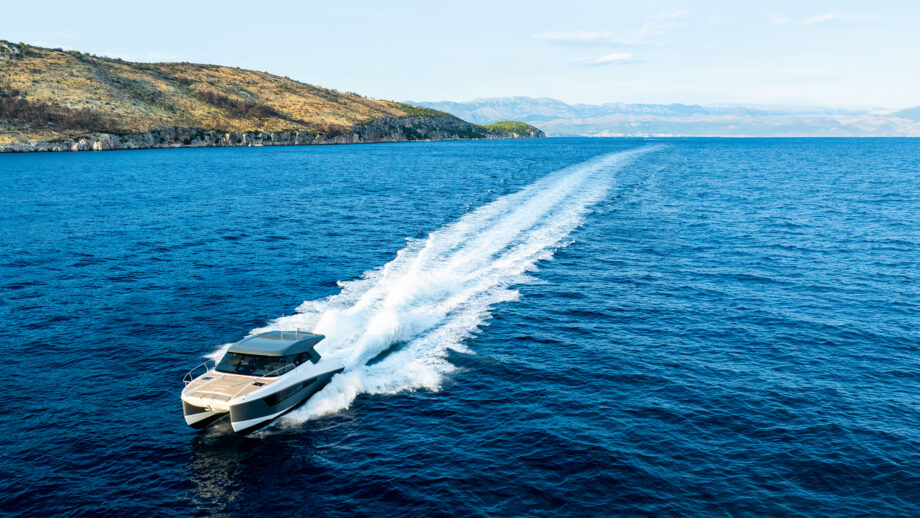
Makai M37 review: £720K cruising cat like nothing you’ve seen before
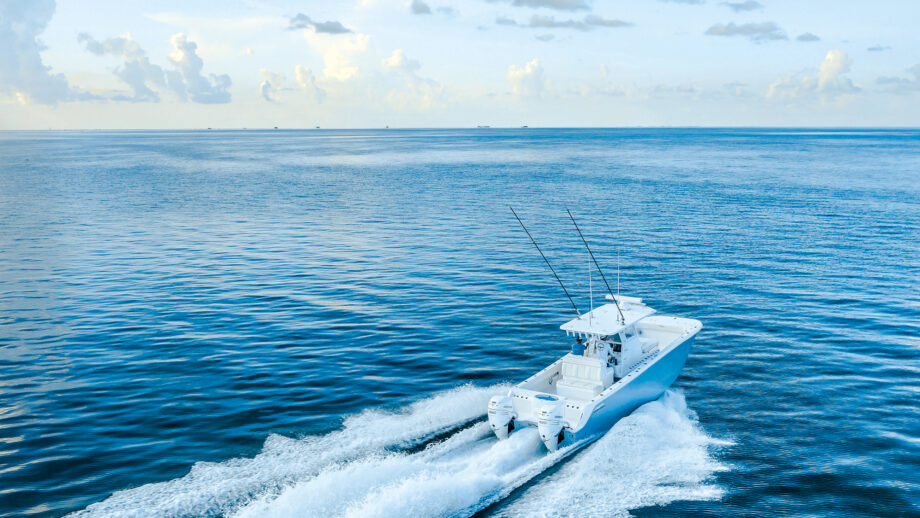
Invincible 33 Catamaran review: All-American offshore sportsfisher that’s not playing around
Ahead of this, in a small starboard zone, between the starboard and forward staircases, sits a slightly isolated square of deck that’s been used here for a set of cabinets and an extremely discreet main-deck mini-helm. You lift up the lid to reveal a 12in plotter, an engine display, a pair of throttles and a joystick, plus a VHF and some basic switchgear.
Again, the view ahead is slightly limited because of the deep-set position, the full-beam bow cabin and the raised backrests for the foredeck sunbeds. But this is a boat you would tend to helm either from up top or from the third station on the port side of the cockpit, and if you opt for the enclosed sky lounge, then the main deck helm isn’t necessary at all so its limitations are by no means critical.
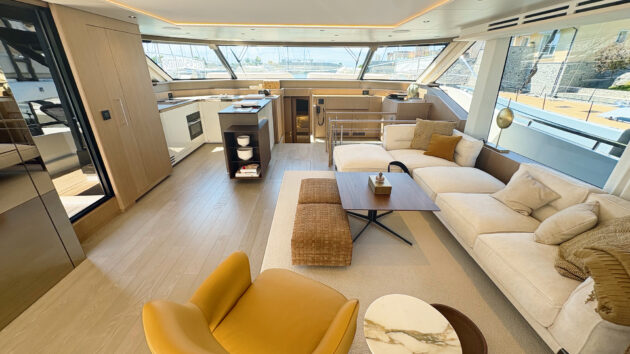
Part of the M7’s customisation potential involves lots of open deck space with your choice of freestanding
Across from this, on the broader port side, sits the galley – and a very impressive one it is too. It uses a deep wraparound C-shaped design, so you can stand behind the work surface and look either out to sea or inboard toward the rest of the saloon guests. It’s really well specced too. In addition to plenty of storage cabinets, you get a wine cooler, a dishwasher, a large two-part Miele stove with integrated extractor, a two-part sink, an ice maker and a cutlery and crockery cupboard with bespoke slide-out bamboo trays.
There’s also a full-height fridge freezer with a neat brass locking catch for security at sea, as well as a tall thin cabinet for your bottles and condiments. You can do away with the sauces cupboard and spec a larger American-style fridge freezer instead but either way, this very much ties into the modern trend toward the kitchen being used less as a simple service centre and more as a social and gastronomic hub.
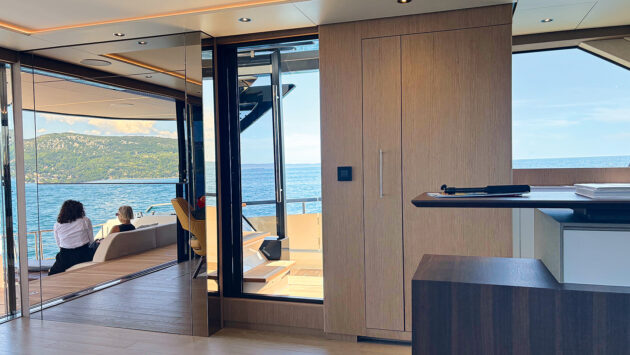
A side door and mirrored bulkhead help mitigate the limited views on the port side
Space for 8 + 4
Prestige always puts the owner’s cabin squarely at the heart of the M-Line experience, so it’s no surprise to see it excel here too. It takes full advantage of the plunging bridge deck to deliver a large, dramatic space with light flooding in from the hull windows on either side. It shares the same staircase as the port VIP but that’s by no means a problem.
And while the checklist of provisions – a central bed, a desk, a settee and a bright his-and-hers bathroom – might sound fairly commonplace, the way each is designed and executed makes this feel like a very special part of the boat. The angled corner desk is particularly well conceived for those who need to do a bit of work away from home, and the bathroom, with its split facilities and the muted sparkle of its glass-lined backlit cabinets, feels delightfully different.
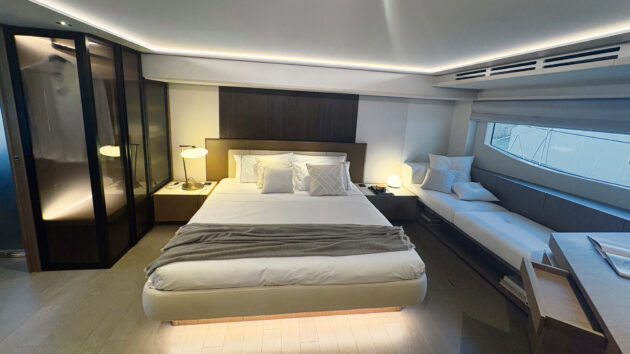
The full beam owner’s cabin uses subtly lit cabinets to divide off the bathroom
True, the sliding door to cordon off that space ought to be made from glass rather than wood to keep that light flowing, in the same way as it does on the larger M8. But it’s a very successful space nonetheless.
The VIP cabin, though less playful, is also neatly done. It uses a massive hull window and makes best use of that with a bed that faces outboard. It also mitigates modest space with a mirrored bulkhead at the entry point and undercut furniture in the form of the beds, desks and bedside tables to impart an attractive sense of openness.
There’s another comparable double on the starboard side, as well as a twin with cleverly staggered beds. And while the twin and Lifejacket crew cabins use a wetroom-style arrangement, the main guest doubles both feature bathrooms with separate showers and neat little recessed alcoves for your shower gear and extraction vents.
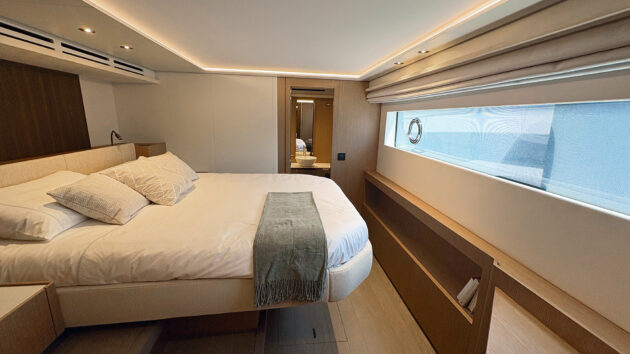
The port and starboard double cabins use undercut furniture, outward-facing beds and mirrored bulkheads to help elevate the ambience
The only potential issue here is the absence of a proper day heads – and that’s fair enough you might say. After all, a day heads is not always a standard feature on a 58ft boat. But as we’ve pointed out, this is a high-volume cruising boat with day spaces for up to 20 people. It’s a boat that is aiming squarely at the 75ft segment, so the expectations are different. The M7’s provision of a two-berth crew cabin as standard certainly helps, but accessing the crew ensuite involves climbing down a ladder and then folding that ladder flush against the aft bulkhead to free up the arc of travel required to open the heads door.
In short, if you want a relatively natural day heads, then make sure you spec the optional second crew cabin, beneath a hatch on the port side of the aft cockpit – and even then, be aware that the young, the old and the infirm will still need to traipse through the guest bunk room to access the bathroom in the forward part of the starboard hull.
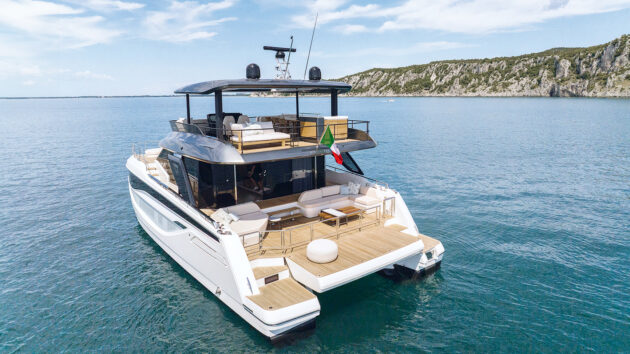
It’s tough to pick a winner from the three outdoor decks
Easy does it
What you don’t tend to expect of a beamy, volume-intensive, deep-chested powercat is driving thrills – and in all honesty, you don’t get them. But the M7 does feel very well judged.
In the absence of any real swells, we try our hardest to find some decent wakes from passing ferries, before leaping through them from every angle at 20 tides, like juvenile PW pilots intent on getting some air. Interestingly, though, at no point do we feel the shudder of the bridge deck bottoming out or see a plume of seawater puffing out over our foredeck. And if that’s pleasing to see, so is the breadth of the cruising band…
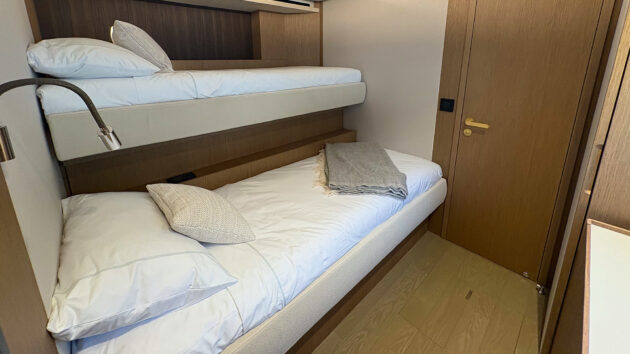
Staggered bunks make very good use of the starboard hull shape
With the standard twin Volvo Penta D8-550s on V-drives, a moderate cruise of nine knots burns just 3 litres per nautical mile for a range of around 800nm. That does increase to around 10lpm at 12 knots for a range in the low to mid 200s but what’s particularly useful here is the fact that it remains at that level right up to 19 knots, only dipping to 212nm at the very top end. And you can also increase that range by upgrading the standard 2,900-litre tanks to 3,600 litres instead.
The upper helm is good too. It almost encourages you to stand and the various touch points are well arranged to enable that. In doing so, you trade protection for big views of the boat hull but that in itself is quite a pleasant thing. When you close up the various doors, the refinement from the main deck saloon is also very decent. But again, if cruising refinement really matters to you, then opt for the sky lounge and, like the market’s best tri-deck motoryachts, you can expect the decibel levels to plummet from the mid 60s to the mid 50s for whisper-quiet serenity on long passages.
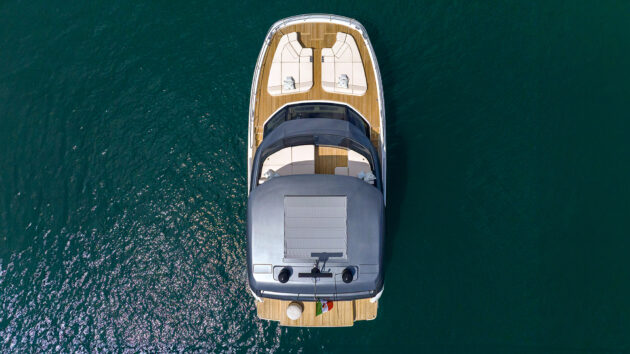
As on most wide-beam powercats, there is plenty of room for a powerful solar array
Prestige M7 specifications
LOA: 58ft 6in (17.84m)
BEAM: 24ft 10in (7.56m)
DRAFT: 5ft 1in (1.55m)
DISPLACEMENT: 39,499kg (light)
FUEL CAPACITY: 2,900 litres
WATER CAPACITY: 760 litres
ENGINES: 2 x Volvo Penta D8-550s on V Drives
RCD: A12-D20
Prestige M7 costs and options
Price: from €3.8M ex VAT. Test boat includes the following options:
Flybridge hardtop: €102,000
Extra crew cabin: €71,700
Tropical-spec AC: €44,200
Main deck control station: €54,400
Hydraulic passerelle: €53,800
 If you enjoyed this….
If you enjoyed this….
Motor Boat & Yachting is the world’s leading magazine for Motoryacht enthusiasts. Every month we have inspirational adventures and practical features to help you realise your sailing dreams, as well as tests and news of all the latest motorboats.
Plus you’ll get our quarterly Custom Yachting supplement where we share the last on offer in the superyacht world and at the luxury end of the market.
Build your knowledge with a subscription delivered to your door. See our latest offers and save at least 30% off the cover price.
Note: We may earn a commission when you buy through links on our site, at no extra cost to you. This doesn’t affect our editorial independence.
Verdict
This big, beamy, deep-chested boat is impressive in a lot of ways. True, the compromised day heads and limited main deck visibility are imperfect; and we would also replace the lower white hull window with the original black version to reinstate the lovely pickle fork aesthetic that does so much to mitigate the inherent bulk of these M-Line boats. But the M7 is a major step up over the M6 in pretty much every way, and while it lacks some of the space, facilities and infectious internal design flourish of the flagship M8, its combination of quality, day space, cruising cabins and customisation potential makes it precisely what Prestige intended – a very real and convincing alternative to the traditional 70-75ft motoryacht in a market that is increasingly ready to embrace that.
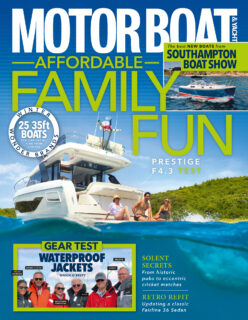


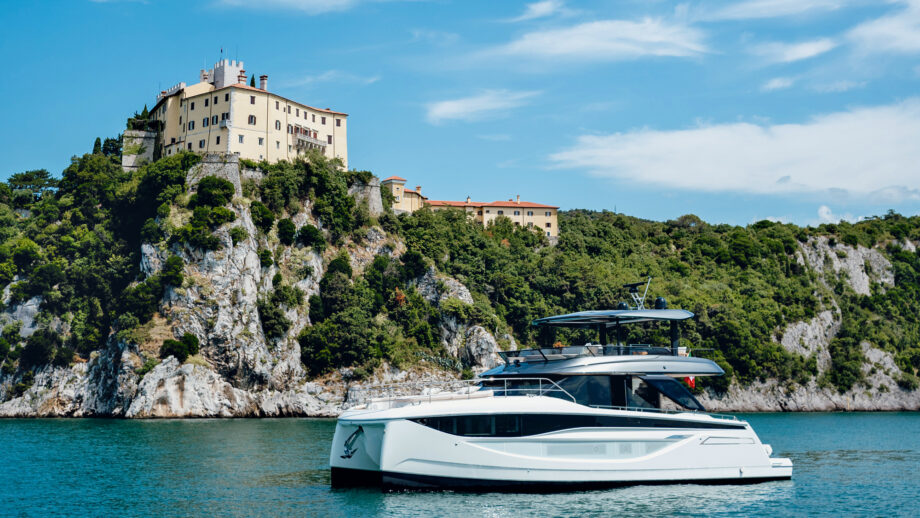
 If you enjoyed this….
If you enjoyed this….